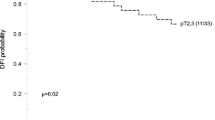Abstract
The urokinase-type plasminogen activator (uPA) and the plasminogen activator inhibitor-1 (PAI-1) are involved in tumor invasion and metastasis as well as wound healing and inflammation. We investigated the impact of tissue injury by preoperative sampling on the level of uPA/PAI-1 in paraffin tissue of 55 breast cancer cases by immunohistochemistry. The tumor area surrounding the biopsy channel was compared with distant intact tumor tissue. uPA and PAI-1 were constantly expressed by the tumor cells. Fibroblastic expression was higher in the tumor area surrounding the biopsy channel than in intact tissue with 47 vs 29 positive cases for uPA (p < 0.001) and 35 vs 25 positive cases for PAI-1 (p = 0.055). A decrease in fibroblastic enzyme expression from the biopsy area to the intact tumor tissue was seen in 21 cases for uPA and 16 cases for PAI-1. This difference was most evident in cases with an interval of 6 days and longer between biopsy and surgery. In conclusion, fibroblastic inflammatory reaction around the biopsy channel affects stromal uPA and PAI-1 expression, which possibly leads to falsely increased enzyme levels in ELISA. Tissue specimen for ELISA analysis should not be taken from the tumor area around the biopsy channel in the resection specimen.

Similar content being viewed by others
References
Andreasen PA, Egelund R, Petersen HH (2000) The plasminogen activation system in tumor growth, invasion, and metastasis. Cell Mol Life Sci 57(1):25–40
Andreasen PA, Kjoller L, Christensen L, Duffy MJ (1997) The urokinase-type plasminogen activator in cancer metastasis: a review. Int J Cancer 72:1–22
Camps JL, Chang SM, Hsu TC, Freeman MR, Hong SJ, Zhau HE, von Eschenbach AC, Chung LW (1990) Fibroblast mediated acceleration of human epithelial tumor growth in vivo. Proc Natl Acad Sci USA 87:75–79
Dublin E, Hanby A, Patel NK, Liebman R, Barnes D (2000) Immunohistochemical expression of uPA, uPAR, and PAI-1 in breast carcinoma. Am J Pathol 157:1219–1227
Duffy MJ, Reilly D, O’Sullivan C, O’Higgins N, Fennelly JJ, Andreasen P (1990) Urokinase-plasminogen activator, a new and independent prognostic marker in breast cancer. Cancer Res 50:6827–6829
Ferrier CM, de Witte HH, Straatman H, van Tienoven DH, van Geloof WL, Rietveld FJR, Sweep CGJ, Ruiteer DJ, van Muijen GNP (1999) Comparison of immunohistochemistry with immunoassay (ELISA) for the detection of components of the plasminogen activation system in human tumour tissue. Br J Cancer 79:1534–1541
Ganesh S, Sier CF, Griffioen G, Vloedgraven HJ, de Boer A, Welvaart K, de Velde CJ, van Krieken JH, Verheijen JH, Lamers CB (1994) Prognostic relevance of plasminogen activators and their inhibitors in colorectal cancer. Cancer Res 54:4065–4071
Harbeck N, Kates RE, Look MP, Meijer-van Gelder ME, Klijn JGM, Jänicke F, Krüger A, Kiechle M, Schmitt M, Foekens JA (2002) Enhanced benefit from adjuvant systemic chemotherapy in breast cancer patients classified high risk according to uPA and PAI-1 (n = 3424). Cancer Res 62:4617–4622
Jänicke F, Prechtl A, Thomssen C, Harbeck N, Meisner C, Untch M, Sweep CG, Selbmann HK, Graeff H, Schmitt M, for the German Chemo N0 Study group (2001) Randomized adjuvant chemotherapy trial in high-risk lymph node-negative breast cancer patients identified by urokinase-type plasminogen activator and plasminogen activator inhibitor type I. J Natl Cancer Inst 93:913–920
Lee AHS, Gillett CE, Ryder K, Fentiman IS, Miles DW, Millis RR (2006) Different patterns of inflammation and prognosis in invasive carcinoma of the breast. Histopathology 48:692–701
Liotta LA, Kohn EC (2001) The microenvironment of the tumour–host interface. Nature 411:375–379
Look MP, van Putten WLJ, Duffy MJ, Harbeck N, Christensen IJ, Thomssen C, Kates R, Spyratos F, Fernö M, Eppenberger-Castori S, Sweep CGJ, Ulm K, Peyrat JP, Martin PM, Magdelenat H, Brünner N, Duggan C, Lisboa BW, Bendahl PO, Quillien V, Daver A, Ricolleau G, Meijer-van Gelder ME, Mander P, fiets E, Blankenstein MA, Broet P, Romain S, Daxenbichler G, Windbichler G, Cufer T, Borstnar S, Kueng W, Beex LVAM, Klijn JGM, O’Higgins NO, Eppenberger U, Jänicke F, Schmitt M, Foekens JA (2002) Pooled analysis of prognostic impact of urokinase-type plasminogen activator and its inhibitor PAI-1 in 8377 breast cancer patients. J Natl Cancer Institute 94:116–128
Nielsen BS, Sehested M, Suun S, Rank F, Timshel S, Rygaard J, Johnsen M, Dano K (2001) Urokinase plasminogen activator is localized in stromal cells in ductal breast cancer. Lab Invest 81:1485–1501
Olumi AF, Dazin P, Tlsty TD (1998) A novel coculture technique demonstrates that normal human prostatic fibroblasts contribute to tumor formation of LNCaP cells by retarding cell death. Cancer Res 58:4525–4530
Pappot H, Gardsvoll H, Romer J, Pedersen AN, Grondahl-Hansen J, Pyke C, Brunner N (1995) Plasminogen activator inhibitor type 1 in cancer: therapeutic and prognostic implications. Biol Chem Hoppe Seyler 376(5):259–267
Pyke C, Ralfkiaer E, Tryggvason K, Dano K (1993) Messenger RNA for two type IV collagenases is located in stromal cells in human colon cancer. Am J Pathol 142:359–365
Schäfer BM, Maier K, Eickhoff U, Todd RF, Kramer MD (1994) Plasminogen activation in healing human wounds. Am J Pathology 144:1269–1280
Schmitt M, Janicke F, Moniwa N, Chucholowski N, Pache L, Graeff H (1992) Tumor-associated urokinase-type plasminogen activator: biological and clinical significance. Biol Chem Hoppe Seyler 373(7):611–22
Sweep CGJ, Geurts-Moespot J, Grebenschikov N, de Witte JH, Heuvel JJTM, Schmitt M, Duffy MJ, Jänicke F, Kramer MD, Foekens JA, Brünner N, Brugal G, Pedersen AN, Benraad TJ (1998) External quality assessment of trans-European multicentre antigen determinations (ELISA) of urokinase-type plasminogen activator (uPA) and its type-1 inhibitor (PI-1) in human breast cancer tissue extracts. Br J Cancer 78:1434–1441
Conflict of interest statement
We declare that we have no conflict of interest.
Author information
Authors and Affiliations
Corresponding author
Rights and permissions
About this article
Cite this article
Haas, S., Park, TW., Hahne, J.C. et al. Influence of preoperative core biopsies on uPA/PAI-1 expression in breast cancer tissue. Virchows Arch 452, 277–283 (2008). https://doi.org/10.1007/s00428-007-0563-8
Received:
Revised:
Accepted:
Published:
Issue Date:
DOI: https://doi.org/10.1007/s00428-007-0563-8




